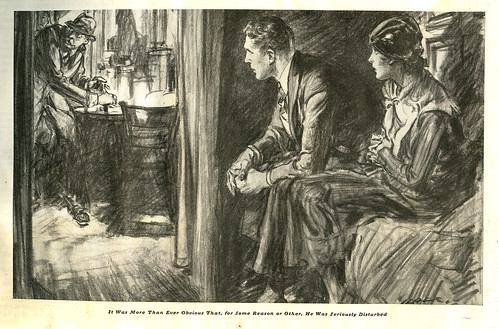Again, from the same copy of The Saturday Evening Post (April 13, 1934) I give you two illustrations by Henry Raleigh. I love the line work. You see the structure being built. The quickness of it, the movement. Really nice drawings.
Click on two images below to see them larger.
These drawings were used to illustrate a story by E. Phillips Oppenheim (October 22, 1866-February 3, 1946) called "The Strange Boarders of Palace Crescent." The first few lines:
"The first thing which struck Roger Ferrison as odd about Mrs. Dewar's apparently respectable Palace Crescent boarding house was the elderly manservant's insistence that all the boarders hand up their keys when they retired. Yet at two A.M., after everyone had ostensibly gone to bed, five keys were missing—their owners obviously abroad in the London night."
Oppenheim was an English novelist known for writing thrillers. From Wikipedia:
Much of Oppenheim's work possesses a unique escapist charm, featuring protagonists who delight in Epicurean meals, surroundings of intense luxury, and the relaxed pursuit of criminal practice, on either side of the law.

As to Henry Raleigh. He was born into poverty in 1880 in Portland, Oregon and committed suicide "...jumping from the window of a sleazy hotel in Times Square in 1944." You can read an interesting piece written by Raleigh's granddaughter, Nora Raleigh, by clicking on the link above.
The following is from an old book on my shelf, Advertising in America: The First 200 years, published in 1990 by Abrams.
Raleigh was known as the illustrator of sophisticated, high society fashion–he did all the stories of F. Scott Fitzgerald, William Faulkner, and the like—in the Saturday Evening Post. When he designed ads, he carried with him the patina of Manhattan and Hollywood and gave the product a tacit endorsement. He did Maxwell House ads for nearly forty years always identifiable by his ink-sketch style overlaid with colored washes. (SOURCE: Advertising in America: The First 200 Years, Charles Goodrum and Helen Dalrymple,Harry N. Abrams, Inc. 1990)And the following is from Ask Art.com:
Etcher, illustrator, lithographer, painter. Born in Portland, OR on Sept. 23, 1880. "Harry" Raleigh moved to San Francisco with his family in 1888. After studying at the Mark Hopkins Art Institute during 1896-1901, he took his first job as a sketch artist for the San Francisco Examiner. While there, William Randolph Hearst noticed his talent and encouraged him to move to NYC which he did in 1913. There he continued newspaper work for the World while illustrating for Harper's Bazaar and The Saturday Evening Post. (SOURCE: AskArt.com)
Here are several pieces shown at AskArt.com.




Raleigh also illustrated several posters during World War I.



To read a well written piece about Raleigh with examples and a discussion of his work click Illustration Art.
And here is a lithograph done by Raleigh.

Three Figures on a Park Bench --- 1919, Lithograph.Edition not stated. Signed in the stone, lower right. Inscribed To Chas. Prulets - Henry Raleigh 1933 in pencil. Image size 7 3/4 x 10 inches (197 x 254 mm); sheet size 10 7/16 x 13 5/16 inches (265 x 338 mm). A fine, rich impression, on cream Japan, with full margins (3/4 to 1 1/4 inches). Pale glue stains on the sheet edges recto, well away from the image, otherwise in excellent condition.$550. (SOURCE: Keith Sheridan)
Again, if in time I discover more of Raleigh's work in my ephemera I will post it.














Oh yes please. I love these drawings, they are so evocative of their time. I think it is the soft pencil/charcoal (?) lines that make them so attractive.
ReplyDeleteI went in search in old magazines for more of his work, but so far nothing. There are some other illustrators I'll feature whose work is also wonderful.
ReplyDelete